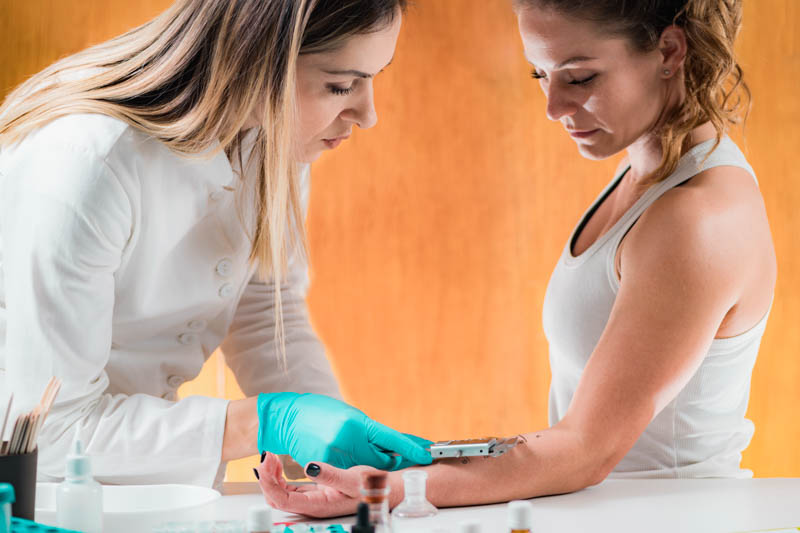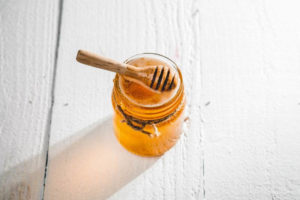Bee sting allergy testing is the first step toward preventing an emergency. Discovering your (or a loved one’s!) risk of an allergic reaction now will give you ample time to prepare. You’ll be able to pursue creating a sting emergency plan with first aid kit, obtaining an epinephrine pen, or starting venom immunotherapy. But if you don’t know your risk, there’s a chance you’re not taking bee stings as seriously as you should. So, now is the time to learn the basics of bee sting allergy testing.
Below, we’ll cover specifically who should get tested and why, how long testing takes, and a general step-by-step process.
Why Do Bee Sting Allergy Testing
People rarely put themselves through something uncomfortable if they don’t know the benefit. So, let’s talk about why it may be useful for you to do allergy testing.
You Had an Allergic Reaction Post-Sting
If a bee or wasp stung you, and you had an allergic reaction, it’s time to get looked at. There’s no telling how bad your next response to a sting will be. If you react to the allergy test, you will know to take bee stings more seriously and seek preventative treatment.
Talking to a local medical professional is the best way to get the care you need.
You Don’t Know What Stung You
Many patients tell their doctors they have no clue which insect stung them. If that’s the case for you, how will you know which stinging insects you genuinely need to avoid?
Allergy testing can provide you with this crucial information. You can learn which stinging insects (honey bees, wasps, hornets, etc.) you’re allergic to.
You Want to Know How Sensitive You Are to Venom
Maybe it’s been a while since your last sting, but you know it was rough. Don’t wait for another sting before seeking help. Getting tested can give you a more concrete understanding of your risk. Who knows, you may be a candidate for venom immunotherapy. It’s better to find out now.
Bee sting allergies are serious
Why You Shouldn’t Do Bee Sting Allergy Testing
Of course, it’s ideal that everyone who should be tested for bee and wasp sting allergies gets tested. It’s crucial! However, some people should wait it out.
If you’re pregnant or breast-feeding, a doctor may ask you to wait to be tested. But if your allergy is an emergency, call a doctor immediately.
Also, if you were stung within the past 2 to 4 weeks, you may be asked to wait. Otherwise, your testing may result in a false negative.

HOW LONG DOES IT TAKE TO BE TESTED FOR A BEE STING ALLERGY?
Most likely, you will need to set aside four hours of your day. Some doctors will encourage you to bring snacks or even a packed lunch. While taking a half or full day out of your schedule for testing doesn’t sound convenient, it’s necessary.
Testing is done incrementally, meaning you’ll start with a very tiny bit of exposure to venom and see if you can work your way up to a larger (but still minimal) amount of the allergen. After each exposure, you’ll need to wait roughly 30 minutes to see the extent of your reaction before moving onto the next phase of the test. A reaction will appear in the form of a red bump, or hive, at the test site.
As soon as a reaction (of a size determined by your doctor) appears at the test site, you will stop testing. Perhaps you will reach this threshold without taking the full length of the appointment. But if you don’t react to the venom, you will need to continue testing to the maximum extent to confirm your results.
Contact a medical professional near you to get an exact estimate of how long your appointment may be.
WHAT EXACTLY IS BEING TESTED?
You will most likely be tested for a few different stinging insect species: honey bee, hornet, wasp, etc. An allergist, in a controlled setting, puts your body in contact with the allergen. Then, there is a release of histamine if your body produces enough IgE antibodies for the allergen. Histamine will produce a hive, and the size of the hive reveals if you have an allergy.
It is also possible to do a blood test, measuring the amount of a specific IgE antibody in your blood. It’s more common for primary care physicians to order this test. Allergists often prefer scratch (also called prick) and intradermal testing.

BEE STING ALLERGY TESTING: STEP-BY-STEP
Now, let’s walk through the basics. Here are seven steps you can expect to experience. It’s important to note that there will be variations between medical professionals and their strategies.
1. Paperwork
The first item on the list is filling out all the necessary paperwork. You’re probably not surprised! This is a standard first-step for seeing a new doctor.
Make sure to bring your:
- Insurance card
- ID
- List of medications and supplements
2. Talking with the Doctor
For testing purposes, the doctor and/or nurse must know all about your reactions to bee stings. Truly, your medical history here is essential! If it’s helpful for you, try writing a few sentences down at home beforehand. Answer questions like:
When were you last stung?
Do you know which insect stung you?
How much time passed before you started experiencing symptoms?
What symptoms did you experience?
How long did your symptoms last?
What relieved your symptoms?
Do you have a history of reacting to stinging insects?
Also, if you have questions about testing, make sure to ask before getting started.
3. Prick Testing
As a pre-test, a medical provider will introduce a minimal amount of venom into your skin with a prick or puncture. Then, your allergist will use your pre-test results as a starting place for the actual testing. Allergists have tools that make prick testing quick and easy. Lastly, after a minute or so, any extra venom will be wiped from your arm.
4. Waiting
You can expect the test site to be examined after at least 15 minutes. If there is a reaction, the medical provider will record the size. Then, your doctor will use these results to determine if and how you move onto the next step.
5. Intradermal Testing
Intradermal testing is completed with a small injection. First, a medical professional or you will cleanse the skin with soap and water or wash with alcohol or another antiseptic. Next, they will insert a small needle under the first few layers of skin. Lastly, a minimal amount of venom extract is injected.
6. More Waiting
Again, you will wait about 15 to 30 minutes for a reaction. If no reaction occurs, you may repeat steps 5 and 6 with an increased amount of allergen. If you react, the doctor can determine your allergy. And if you don’t respond, you may learn that your risk of allergic reaction is very minimal or none!
7. Treatment or More Testing
If it is apparent that you have a severe bee sting allergy through testing, your doctor will want to talk about treatment options. While epinephrine pens are a great tool in an emergency, be prepared to speak about venom immunotherapy. It’s is up to 98% effective in deterring systemic allergic reactions and can help you feel confident outdoors again.3 Your doctor will know if venom immunotherapy is an option for you based on your test results.
If your test seems inconclusive, but you’ve had what appeared to be an allergic reaction in the past, more testing may be needed. Your doctor will have suggestions for the best path forward.
NOW IS THE TIME FOR BEE STING ALLERGY TESTING
If you have any suspicion that you may be allergic to bees or other stinging insects, don’t wait. Talk to a local medical provider today about your testing and treatment options.


Find a Local Allergist
If you think you have a bee sting allergy, don’t wait for an emergency. Instead, talk to an allergist about testing and venom immunotherapy.




